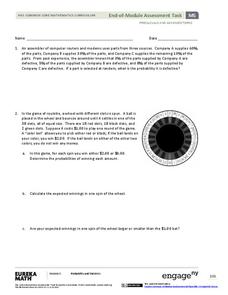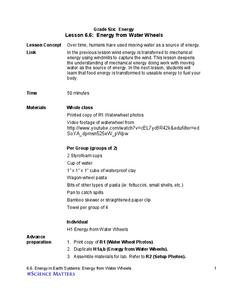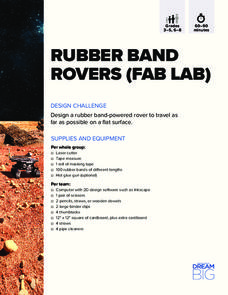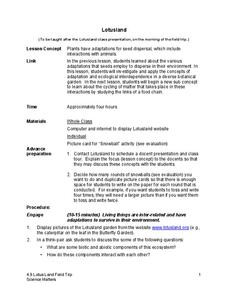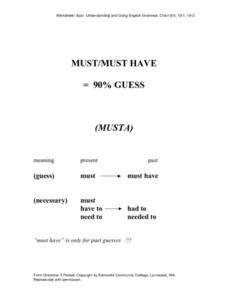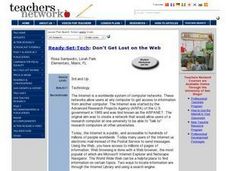EngageNY
Linear Transformations Applied to Cubes
What do you get when you combine a matrix and a cube? Well that depends on the matrix! Pupils use online software to graph various transformations of a cube. Ultimately, they are able to describe the matrix that is responsible for a...
EngageNY
Estimating Probability Distributions Empirically 1
What if you don't have theoretical probabilities with which to create probability distributions? The 11th installment of a 21-part module has scholars collecting data through a survey. The results of the survey provide empirical data to...
EngageNY
End-of-Module Assessment Task - Precalculus (Module 5)
Give your young scholars a chance to show what they've learned from the module. The last installment of a 21-part series is an end-of-module assessment task. It covers basic and conditional probabilities, expected value, and...
Biology Corner
Technology and Inventions Project
Technology—what exactly is it? Find out with a project designed to inspire the inner inventor in us all. The activity begins with a captivating podcast and a search of multiple websites that display different inventions and technology,...
Science Matters
Eruptions and Volcano Types
The Mammoth Lakes area regularly releases warnings to hikers and skiers to be careful because melting snow releases trapped gases from volcanic vents. The 17th lesson in the 20-part series opens with a demonstration of carbon...
Science Matters
Landforms from Volcanoes
Three major types of volcanoes exist: cinder cone, composite/strata, and shield. The 18th instructional activity in a 20-part series covers the various landforms created from volcanoes. Scholars work in pairs to correctly...
Science Matters
Energy from Water Wheels
Historians believe the first vertical water wheel was invented in Rome during the Augustan Age. The sixth instructional activity in the series of 10 has scholars experiment with designing their own water wheels. Through testing various...
LABScI
Population Dynamics: The Predator-Prey Lab
Wolves eat better when the bunny population increases, but how long does that last? A series of 12 biology lessons uses the sixth installment to explore the predator-prey relationship between bunny and wolf populations. Young scientists...
Shodor Education Foundation
Graphit
No graphing calculator? No worries, there's an app for that! Young mathematicians use an app to graph functions. In addition, they can also plot data points.
Shodor Education Foundation
Linear Inequalities
An interactive lesson helps individuals learn to graph inequalities in two variables. Scholars can adjust the interactive to present the inequalities in standard or slope-intercept form.
DiscoverE
Rubber Band Rovers
Get your learners interested in space exploration. Groups design space rovers using design software and then build prototypes of their designs. The farther the rovers can travel, the better. The catch? The rovers must be powered by...
Science Matters
Lotusland
It's time for a field trip! Scholars take their new-found knowledge of adaptations and seed dispersal on a field trip to a local botanical garden. They gain an up-close look at how ecological interdependence works in a distinct...
The New York Times
Trouble in the Hive: Researching the Decimation of Honeybee Colonies
Teach your class about colony collapse disorder and foster discussion about causes and solutions for the honeybee problem. Class members read and discuss an article and participate in one of two detailed activities about pollination and...
Curated OER
Technology Makes It Easier
High schoolers identify different technological devices that make their lives and jobs easier. Instructors demonstrate how to use various devices and allow students to practice using them. This lesson is intended for high schoolers...
Curated OER
Must/Must Have = 90% Guess
In this grammar learning exercise, students learn when to use "must" and when to use "must have" in sentence writing. They then make guesses about the following 10 sentences using "must".
Curated OER
Research Listed Websites for Support for Writing a Summary
Summary writing is tough for native English speakers, let alone English language learners! In this plan, high school English learners examine how to annotate online articles and write a one-page summary. They can post this summary on...
Curated OER
Let's Learn About Firefighters!
Students explore the world of the firefighter through various activities and wrap up the day by writing and illustrating a sentence about firefighters.
Curated OER
Organizing our Favorite Books
Young scholars identify the title and author of stories. They create a database that supplies both graphic and written information to identify a book.
Curated OER
Don't Get Lost on the Web
Scholars discuss purpose of search engines, define World Wide Web, become familiar with website addresses, demonstrate understanding of site updating, create a list of topics about which they would like more information, and visit at...
Curated OER
Literature and Telecommunications
High schoolers read a novel and write short journal entries about the characters, setting and interesting facts. Using email, they share their responses to the novel with other students at a different school. Student also create slide...
Curated OER
Goldie Girl and There, Their, and They're: Homophones and Homographs
Instruct your class on homonyms and homophones. Learners take a pre-test and examine a list of homophones. They also play online word games to practice spelling and usage and write a fairy tale in which they use at least 10 homophones....
Curated OER
Country Comparisons in Current Events Class
Pupils collect political, socioeconomic, geographical, and other data about 10 countries and record their data in a spreadsheet. The information is used to fuel current events discussions.
Curated OER
Loop-based Composing based on Visual Stimuli
Students search the World Wide Web to locate an artistic image that inspires an aural composition. They compose a musical piece using loop-based composition software and use file management and storage techniques to archive project work....
Curated OER
Using Context Clues
Teach your third graders how to find the meanings of words using context clues. Using this reading lesson, discuss how readers can find the meaning of a word by using the sentences around it. They then complete a worksheet in which they...




